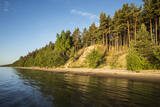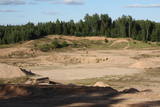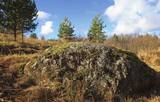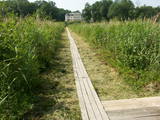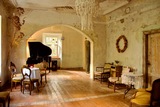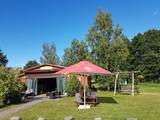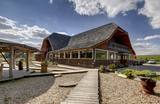| Nr | Name | Beschreibung |
|---|---|---|
|
Die Käserei von Rauna gehört der Familie Ceriņš, die schon 10 Jahre den Käufern 23 qualitative und hochwertige Produkte – Käse, Butter und Röhrennudeln anbietet. Das beliebteste Erzeugnis der Käserei ist der Käse „Zaļais”. Einer der Hauptinhaltsstoffe dieses Produkts ist der Käseklee, der in eigenem Garten angepflanzt wird. Der Käseklee ist eine einjährige krautige Pflanze. Geerntet werden die grünen oberirdischen Pflanzenteile, die in einem mit Holz beheizten Trockner getrocknet werden. Nach dem Abtrocknen werden die Pflanzenteile gemahlen, durchgesiebt und einer Eiweißmasse zugesetzt. Diese Masse wird dünnschichtig in die extra angefertigten Holzkasten geschüttet und getrocknet. Nach der Anfügung des Käseklees erhielt das Produkt ein ausgeprägter Geschmack, Duft und Farbe des Käse „Zaļais”. Nach vorheriger Vereinbarung können die Gruppen (min. 10 Personen) die Käserei besichtigen und mit einem bekanntmachen. |
||
|
Der Meteoriteneinschlag auf Insel Saaremaa liegt ungefähr 7500-7600 Jahre zurück und verursachte einen Krater von 110 m Durchmesser und 22 m Tiefe und 8 weiter kleine Krater. In der Rangliste der Riesenkrater der Welt liegt der Kaali Krater an achter Stelle. Das Kaali Meteoritenkraterfeld auf Saaremaa ist das seltenste Naturdenkmal Estlands und gleichzeitig das eindrucksvollste Kraterfeld in Eurasien. Auf dem Kraterfeld befindet sich das Besucherzentrum von Kaali samt dem Museum für Meteoritik und Kalkstein, einem Konferenzsaal und dem Hotel. Im Museum sind echte Meteoritenstücke ausgestellt. Im Hotel sind kompfortable Zimmer, nebenan befindet sich historisches Wirtshaus Kaali. |
||
|
Die Steilküste von Ēvaži – bis zu der 8-15 Meter hohen Steilküste führt der 0,3
km lange Pfad, an dessen Ende man einen der schönsten kurländischen Anblicke
auf die Bucht von Riga hat.
|
||
|
Dies sind Hügel im nördlichen Ende des Vidzemer Hochlandes. Sie sind ein wichtiges Gebiet für den Nördlichen Nadelwaldgürtel und seine Sümpfe. Hier werden verschiedene Sumpfarten gefunden, sie sind Heimat einer Anzahl wirbelloser Tiere.
|
||
|
Die zentrale und auch schönste Straße in Trakai mit bunten Holzhäusern. Eins der seltenen Kenesa-Gebetshäuser der Welt – ein eingeschossiges Holzhaus mit einem bläulichen Dach. |
||
|
Horse's Footstone has a curvy that recalls a horse's footprint.
|
||
|
The aerial tram across the Gauja is the only vehicle of its type in the Baltic States. It was installed in 1969 with the help of engineers from Georgia. The crossing is 1060 m long, and the cable which crosses the river is just one cable without any supports. The tram rides about 40 metres above the river, and it offers an outstanding look at the local landscapes. During the evening, the tram is used by Bungee jumpers. |
||
|
Der beste Platz, um sich das Schutzgebiet des Vīķi – Sumpfes, in dessen Zentrum sich der Lielauce – See befindet, anzuschauen, ist die Lielauce – Burg, wo ein hölzerner Plankenweg beginnt. Der Pfad leitet den Besucher durch die sumpfigen Ufer des Lielauce – Sees zu einem offenen Teil des Sees, wo man Boot fahren kann. Der Sumpf selbst befindet sich im südöstlichen Teil des Sees. Das Schutzgebiet wurde eingerichtet, um die Biotope und Arten in dem Gebiet zu schützen.
|
||
|
Iespējams apskatīt Kroņvircavas muižas kompleksu, kas bija pēdējā Kurzemes un Zemgales hercoga Pētera Bīrona lauku īpašums ar pili. To pēc hercoga pasūtījuma 1776. - 1785. gadā būvēja galma arhitekts Severīns Jensens. No hercoga pils līdz mūsdienām saglabājies vienīgi ziemeļaustrumu korpuss un virtuve kā atsevišķa ēka. Vispilnīgāk no muižas kompleksa ēkām saglabājušās Kavalieru māja, Pārvaldnieka māja, kurā tagad vietu radis projekts “Muižas istabas”, klēts-magazīna, stallis. Kroņvircavas muižas apbūve ir Valsts aizsardzības objekts. Pili ieskāva liels baroka stila parks ar ūdens parteru, kas kā muižas dārzs sākts ierīkot 1693. gadā. Šobrīd “Muižas istabās” saimnieko ģimene, kas vēlas saglabāt autentiskās mājas vērtības, iedzīvināt džezu uz “Muižas istabu” improvizētās skatuves, izstādīt mākslinieku darbus un svinēt svētkus. Aicinām apmeklēt vēsturiskā un kultūras mantojuma interesentus dzīvās mūzikas pavadījumā atklāt Vircavas bagāto vēsturi, ģimenes piedzīvojumus ar 250 gadīgo namu un sajust īpašo atmosfēru, ko novērtējuši daudzi mūsu apmeklētāji. |
||
|
The owner has a collection of some 2,000 spoons which he has carved from 70 types of wood from trees and bushes during more than 30 years. The smallest spoon is made of osier, while the largest one, “A European Spoon,” is larger than the height of a human being. The artist also produces paintings made of wood. You can watch him at work, purchase the spoons, and tour his museum. |
||
|
At the Žīguri Parish kindergarten, guests are offers a guided tour of forest life. The owner’s stories about the forest and its residents will be of interest to everyone. The Anna Āze Forestry Museum offers some of the true treasures of Latvia’s surprising forest world. It has been declared the best destination for families in Latvia.
|
||
|
Im 15. Jh. kam das Landgut von Preiļi im Besitz der Familie des Grafen von Borch. Die Familie von Borch hat hier bis in die 1860er Jahre gewirtschaftet. Die Stadt hat sich in der ersten Hälfte des 19. Jhs. herausgebildet, indem das Landgut, das Dorf und das Freidorf – die Niederlassung der Handwerker und der Händler – von Preiļi zusammengeflossen sind. Im 19. Jh. wurde in Preiļi ein prächtiges Schloss gebaut und ein Landschaftspark eingerichtet. Heute ist die Stadt ein bedeutendes Zentrum für Wirtschaft (für Käseherstellung und Näharbeiten) der Region Latgale, das seine Traditionen der Folklore, der Handwerker und des Katholizismus pflegt. Besonders empfehlenswert ist eine Führung in der Leitung von Irēna Kjarkuža, die bei der Touristeninformation von Preiļi arbeitet. |
||
|
Das Museum befindet sich in Aknīste, an der Kreuzung der Skolas Straße und Miera Straße. Dieses Museum ist noch ein Ort, der bei der Erkundung der Kultur und der Geschichte der Region Sēlija helfen wird. In dem Museum (eingerichtet im Jahr 1988) kann man eine Sammlung von Altertümern (aus der Steinzeit und Bronzezeit) und Gegenstände besichtigen, die über berühmte Persönlichkeiten aus der Gegend und die Kultur der Selen erzählen. Besonders wertvoll ist die Sammlung des Geschirrs der Selen. |
||
|
Kafejnīca "Stieres" atrodas Jūrmalas – Kolkas ceļa (P 131) malā – kempinga „Stieres” teritorijā. Piedāvā mājas virtuvi visām ēdienreizēm. Maltīti gatavo no Latvijas zemnieku audzētiem dārzeņiem, salātiem, zaļumiem. Zivju ēdieni ir no vietējo zvejniecības uzņēmumu ķertā vai pārstrādātā loma. Piedāvā dažādu svinību galdu klāšanu. Latviešu virtuve: Aukstā zupa, siļķe ar kartupeļiem un biezpienu, kartupeļu un plānās pankūkas, rosols, vietējo zemeņu zupa.
|
||
|
Находится на ул. Базницас, д. 17. Здание построено в XVII веке, как жилой дом кулдигского бургомистра. В 1701 году здесь гостил король Швеции Карл XII, который в передней оставил огромный сундук (2 х 2,5 м), на который после реставрации можно взглянуть и сегодня. |
||
|
Im Hauptgebäude des Kreismuseums (ganzjährig geöffnet) und in den Filialen (geöffnet in der Sommersaison) bekommen sie einen guten Überblick über die Geschichte der Insel Hiiumaa und der See, Geschichte der Landwirtschaft und Gutshöfe, zaristische Zeit und Estnische Republik, über die Geschichte der Dago-Kertelsche Tuchfabrik, über die Sowjetzeit, u.a. Im Langen Haus finden Workshops für Kulturerbe statt. |
||
|
Lieliska vieta svinībām vai atpūtai Minijas ielejā Žemaitijā. Kafejnīca 100 pers. un konferenču zāle, kuras izvietotas 6 ha lielajā teritorijā. Spēļu laukumi gan bērniem, gan pieaugušajiem. Kanoe, burbuļvanna un pirts. Nakšņošanai viesnīcas numuriņi, koka namiņš vai 2-zvaigžņu kempings. Pieejama ēdināšana. |
||
|
Ein nettes Café, das sich im alten Volkshaus befindet. Darin werden einzigartiger Käse, Teigtaschen, Suppe aus Pfifferlingen, Bohnen und Graupen, vadsas, Getränk aus Mädesüß-Sirup zubereitet. |
||
|
Am Ufer der Venta erhebt sich eine wahre Perle der Holzarchitektur - die mit romantischen Geschichten und Legenden umwobene und unlängst erneuerte „Villa Bangert“. Man erzählt sich, dass ein gewisser Kapitän Bangert dieses Gebäude seiner Braut in Paris gekauft habe. Seit 1940 befindet sich in diesem Haus das Heimatmuseum der Stadt Kuldiga. In dem Museum hat man nach der Rekonstruktion der Räume die einzigartigen Wandmalereien und verschiedene andere Details im Interieur wiederhergestellt und somit eine Exposition – die Wohnung der Familie Bangert - geschaffen, die uns ein Bild davon gibt, wie eine wohlhabende kuldigaer Familie zu Beginn der 20er Jahre gelebt hat. Ausserdem kann man hier auch die Kollektion des Spielkarten- Sammlers Jāņis Mētra sehen. |
||


